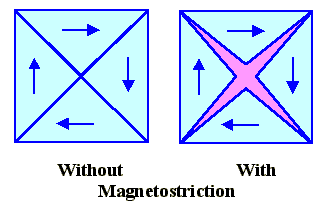
Magnetostriction
When a material (magnetic material) is magnetised, changes in dimension are generally observed. This property of a magnetic material is called magnetostriction.
There are three types of Magnetostriction
- Longitudinal
- Transverse
- Volume
1. Longitudinal Magnetostriction
When a change in the dimension is in the direction of applied field.
2. Transverse Magnetostriction
When a change in the dimension is perpendicular to the applied field.
3. Volume Magnetostriction
When a change in the dimension is perpendicular as well as parallel to the applied field.
Some Important Points
- Magnetostriction is responsible for humming noise in the core of Transformer.
- Magnetostriction is caused by rotation of domain of ferromagnetic material under the influence of the applied magnetic field.
- Positive Magnetostriction: Material expands with an increase in the strength of the applied magnetic field and it contracts when field strength decreases. Example: Ni-Fe alloys.
- Negative Magnetostriction: Material expands with the decrease in the strength of the applied magnetic field and it contracts with an increase in the field strength. Example: Co, Ni.
Application of Magnetostriction
- Under water sound detection
- Generation of supersonic sound
- Generation of high-frequency oscillations
Villari Effect
It is a converse of magnetostriction process. The longitudinal deformation leads to change in magnetic permeability (µ) of the material in the direction of the applied stress. It is also called as Inverse Magnetostrictive effect. Let’s see two cases.
Case-I: Material with positive strain.
- µ increases with expansion.
- µ decreases with contraction.
- Example: Ni-Fe alloys
Case-II: Material with negative strain.
- µ increases with contraction.
- µ decreases with expansion.
